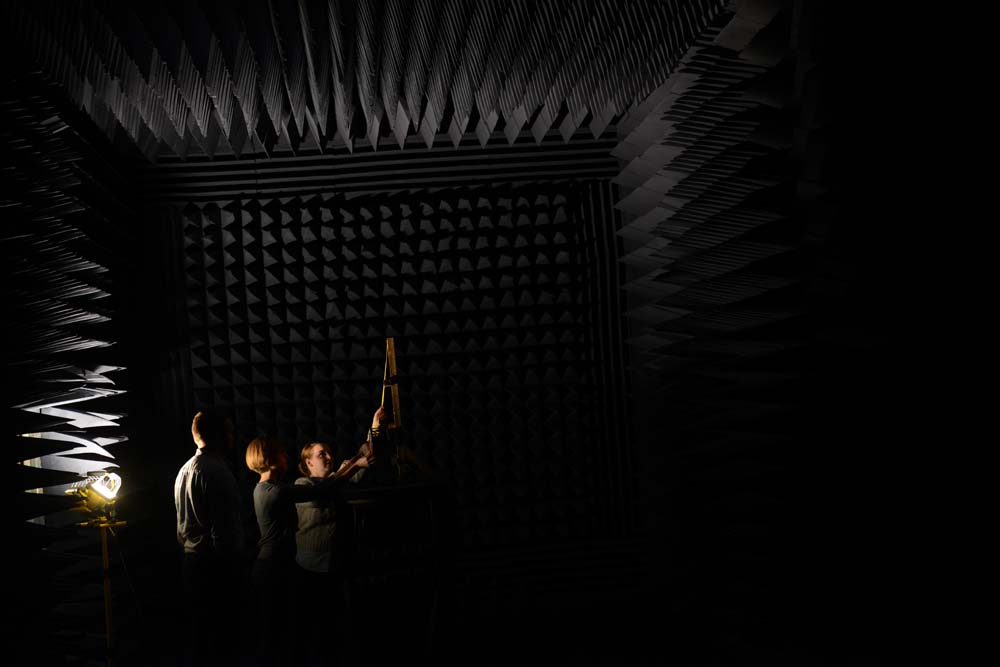Kentucky’s Space Connection
Morehead State University’s Space Science Center launches students in out-of-this world engineering careers
Morgan Harrison, who graduated from Morehead State University in December, has known since she was a young girl that her career path would somehow involve space.
Her newly minted degree in space systems engineering and her work as a researcher at MSU’s Space Science Center have set her on solid footing to make that dream a reality.
“When you tell people in the space community that you have a degree from Morehead State, they’re very impressed,” says Harrison, a Coral Grove, Ohio, native. “It carries a lot of weight.”
New horizons
Home to Morehead State University’s undergraduate and master’s degree programs in space systems engineering—the only aerospace engineering program offered in Kentucky—the MSU Space Science Center is also one of the country’s leading research and development facilities in the emerging field of micro and nano satellites.
MSU researchers have developed particular expertise in modular cube satellite, or cubesat, technology. To date, seven of their cubesats, built by MSU staff and students on site in Morehead, have been launched into space.
Often the size of a loaf of bread or even smaller, microsatellites are less expensive to manufacture and launch into space than large-scale, conventional satellites. That’s why they have the potential to revolutionize the space industry, says Benjamin Malphrus, a Clark Energy Cooperative consumer-member who has served as the executive director of Morehead’s Space Science Center since 1990.
“There are thousands of applications for small satellite constellations, ranging from telecommunications to GPS enhancement, resource monitoring and tactical defense applications,” Malphrus explains. “In a practical way, they can also be used to track ships at sea or monitor forest fires, for example.”
Hands-on learning
Chloe Hart, an MSU senior from Ashland, discovered the Space Science Center and its degree programs through a summer STEM (science, technology, engineering and math) camp for girls called SpaceTrek, held on the MSU campus.
I fell in love with the Space Science Center and the people and program here,” says Hart, whose Space Science Center training as an undergraduate has included operating the campus’s 21-meter parabolic dish space tracking antenna—the largest of its kind on any university campus in the United States.
As a ground station operator, Hart has helped track cubesats launched from the International Space Station during their low-Earth orbit.
“It was a NASA Jet Propulsion Laboratory ASTERIA mission that we were able to work on, which was really incredible,” Hart says. “It’s super hands-on at Morehead. We do everything from building satellites ourselves in our clean room all the way up to tracking them, so we do everything in the life of the mission.” (ASTERIA stands for Arcsecond Space Telescope Enabling Research in Astrophysics.)
Students who graduate from MSU’s space systems engineering program leave ready to excel in the wide-ranging aerospace field, a $14 billion industry in Kentucky alone.
“We have nearly 100 percent placement of our graduates,” Malphrus says. “Our students are highly sought-after and go to work for everybody—from the various NASA centers or big aerospace companies like Lockheed Martin to smaller, partner companies like Rajant Corporation here in Morehead, which works on telecommunications systems, where we have close to 20 graduates.”
“When I go out (in the space science community) and say I’m at Morehead State and I’ve worked with Dr. Malphrus, people do truly know his name,” says Kristen Ammons of Morehead, whose parents are consumer-members of Fleming-Mason Energy Cooperative.
Ammons, who will graduate this May with a degree in space systems engineering, says her MSU undergraduate research has opened multiple doors for her already, including the opportunity to intern at a Massachusetts Institute of Technology-affiliated research lab last summer doing orbital monitoring for a cubesat project called AERO/VISTA.
“I cannot feasibly see myself having the opportunities to do the amount of hands-on research I’ve done had I gone to a different school,” Ammons says.

Lunar Ice Mission
Students and staff at the Morehead State University Space Science Center are finalizing work on a $24 million modular cube satellite (cubesat) set to launch in late 2020 or early 2021 as part of NASA’s Lunar IceCube probe. MSU is the lead research facility on that NASA project. The goal: charting the moon’s surface for lunar ice, which can serve as a source of water.
“NASA has a larger vision of getting to Mars, but building moon colonies will be a gateway to get there,” explains Shanil Virani, who joined the Space Science Center last August as an instructor and as the new director of its Star Theater planetarium.
“It’s incredibly exciting for MSU to be a part of this mission, because water, of course, could be used for human colonies, but it could also be broken apart into hydrogen and oxygen and used as a fuel source for future spacecraft missions launching from the moon to Mars,” says Virani, a Fleming-Mason Energy Cooperative consumer-member. “The first step, though, is to see how much water is there.”
PODCAST: Listen as Virani describes just how big the aerospace industry is in Kentucky.

